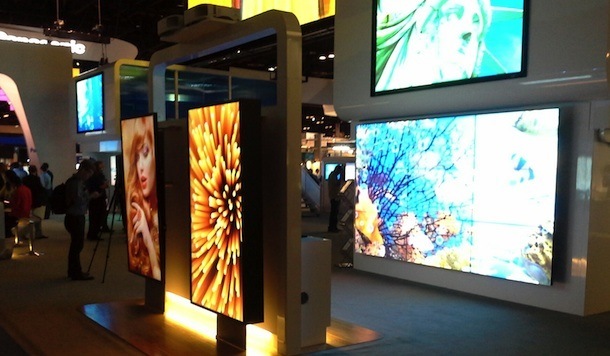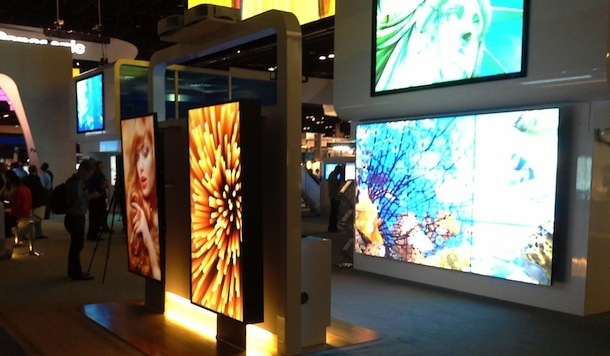
InfoComm Impressions: Day 2
June 15, 2013 by Dave Haynes
ORLANDO – So my grand plans of spending most of the day poking around the Infocomm trade show hall got derailed by meetings and conversations that just kept happening on day 2, but I did manage to get a bit of a walk around the floor and develop some thoughts.
1 – We’re now at a point that big, beautiful displays and near seamless video walls are so common you can walk by them and not even appreciate what’s going on. I used to look at ginormous displays and think, “Holy Crap that’s big!” Now, not so much. If at all. Big and just about seamless is everywhere, and those narrow seams are negating the need for super-duper big single panels. The display and mount guys have got so good at video walls they don’t – in a weird way – seem as impactful. But maybe that’s an insider thing and consumers are indeed wow’ed.
2 – Most of the signage software guys seem to have given up on systems integrators and pro AV resellers as the path to sales glory. Companies like Scala and Omnivex – who’ve long been known as guys selling through “the channel” weren’t even here. They are selling direct or have a small stable of integrators who get things done and aren’t bothering with the rest, who don’t.
Undoubtedly, all kinds of software companies had people here, but precious few of them had booths. The main exceptions were BrightSign and Visix, though I am undoubtedly forgetting some. Others had small patches of carpet and wall in the booths of some of the big display guys.
The reason I hear for that, over and over again, is that companies who are in the business of selling everything from KVM switches to embedded speakers for conference rooms are not all that well equipped or trained to sell a solution. Being able to explain Digital Signage 101 to clients is all well and good, but this group has very few people who can talk to clients about the business model and return from digital signs.
3 – I’ve seen enough of these on-the-floor education stages at various shows, to conclude they don’t seem to have much success attracting people, but they probably are successful extracting appearance dollars from the vendors who end up yakking away on the stage to a handful of people. The one this year had better content, but I’m not convinced it had much of an audience.
4 – The value of Infocomm as a big event for companies purely in the digital signage space – excluding the display, mount and distribution (cables and connectors) guys – is becoming a bit of an open question. If your company is going to invest in a catch-all show, that’s probably DSE, not Infocomm. But there’s a lot of companies pushing limited marketing/event dollars into vertically oriented shows like those for the restaurant, hotel, health and transport industries.
Then again, the show announced today it eclipsed 35,000 bodies this year, a record.
5 – Not a lot of innovation evident in the signage-specific side of the show. I had several people ask me if I had seen anything that knocked my socks off. Nope. They all said they hadn’t seen anything either. That’s not at all saying there wasn’t a lot of terrific product on the floor, just nothing new and different like we’ve seen in past years, like MicroTiles and Nanolumens. I still like those 1.9 mm pixel pitch LED walls, but they are still at a price point that would cause heart attacks. There was nothing I was told I had to see.
On Thursday, I hung out a little with a startup called Exxothermic, which has a product that takes TV audio and converts it to a digital signal you could hear on a smart phone. This would be VERY nice in a crowded sports bar where your game of choice may be on a screen, but the house audio is for another game. A company called Hear My Lips also does this, but these guys seemed a little more sophisticated and had some smartphone capabilities to choose not only the audio but language options.
I also got a rundown on the system on chip display offer from Philips, which is a bit like Samsung’s Smart Signage platform, but then again not. Philips has an ARM A9 processor in some displays now in production and ready for release next month. The things are set up to run HTML5 and use Opera as a browser, however the units only have 2 GB of storage and are meant to be streaming receivers over an IP network, the feed coming from a PC somewhere else on the network.
I liked what I saw of BrightSign’s software, which is pretty sophisticated for a company that trades on solid-state boxes that just run and run and run (people think about BrightSign more for the boxes than the platform).
I also spent time looking at a Singapore company called Media2Stream that has been around in that region for years and is now trying to crack North America with an SMB product that is $500 all in, solid state Intel Cedar Trail chip and software.
I TRIED to get the rundown on what Cisco is now peddling for a digital signage offer – right at the front of the booth, near reception – but I tried 10 minutes of just standing there and no luck finding anyone to come over and tell me what was what. Great company, but eternally hopeless when it comes to a sideline project like digital signage. Move on, giant company.
At the airport, steeling for an amateur hour flight full of people who rarely travel by air (and have kids in tow). Whee!
The show is back in the blast furnace of Las Vegas next year, which has actual taxi companies, roughly a billion more restaurant options, and a crazy-busy airport that seems to manage being crazy-busy. The Orlando security set-up is a total cluster<naughty word>.
Enjoy your weekend.




What products / services etc would you have liked to have seen there but were missing?
I’m not sure there was anything missing, though I would have loved to have seen companies with working demos of low-cost ARM devices and the Leap Motion gesture device.
The one yawning hole in the digital signage and broader Pro AV sector was creative. Didn’t see one company other than the ScreenFeed and DigiChief guys, and they do feeds. I thought content was king, because that’s what speakers keep going on and on about.
For your point 3 above, here’s some stats –
My presentation at DSE had 50+ attendees, my presentation at Infocomm had 10.
Hi Dave,
I manage the Cisco digital signage product portfolio and was at the InfoComm show floor with our solution partner. We always had about 4 people around our digital signage booth to cover the busy traffic. I had a lot of fun talking to customers, resellers and potential ecosystem partners. We had four displays at the digital signage booth, two of which were right behind the reception desk and the other two on the opposite side behind the wall. We didn’t want to crowd the reception area too much, so most of the customer conversations were behind the wall. If you walked around Cisco booth a bit, you will sure see us there. I am sorry to hear your experience. We will try to improve our booth layout and reception to avoid this confusion in the future.
To respond to your speculation about Cisco’s direction of the digital signage technology, Cisco continues to invest in this technology with strong roadmap and build robust partner ecosystem to deliver next-generation digital signage experience. I talked to quite a few customers and partners during the event and they are excited about Cisco’s roadmap, the technology linkage to the our intelligent network platform, and our partner ecosystem approach for enabling extended use cases. Customers are comfortable choosing Cisco with our end-to-end solution in business video, collaboration and broader networking infrastructure.
Please feel free to reach out to me for any questions regarding Cisco digital signage strategy and offers. I hope to see you in the future tradeshow events.
Thanks and regards !
Qiang Huang